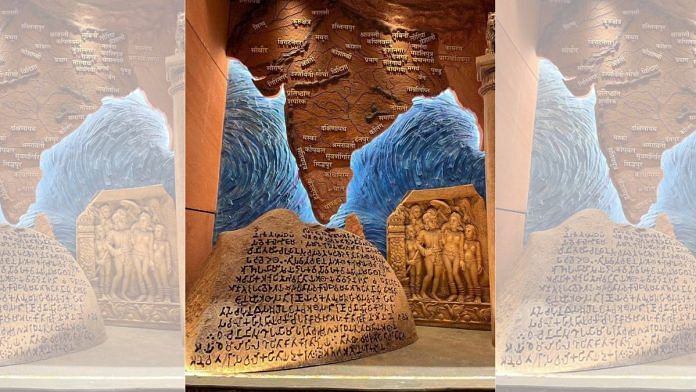New Delhi: The mural in the new Parliament building that has triggered a controversy in Nepal is meant to show the spread of the ‘Ashokan Empire’, the Ministry of External Affairs clarified Friday.
Media reports quoted MEA spokesperson Arindam Bagchi as saying, “The mural in question depicts the spread of the Ashokan empire and the idea of responsible and people-oriented governance that (Emperor Ashoka) adopted and propagated.”
The issue was sparked by a tweet from Union Minister of Parliamentary Affairs Pralhad Joshi on the day of the inauguration of the new Parliament, 28 May, saying, “The resolve is clear — Akhand Bharat.”
However, what riled many in Nepal was that the mural, a map of the Indian subcontinent in ancient times highlighting its important kingdoms and cities, covers Kapilavastu and Lumbini in present-day Nepal. Places such as Sindhu, Takshashila, now in Pakistan, are also included.
The controversy snowballed on social media over the next few days, almost coinciding with Nepal Prime Minister Pushpa Kamal Dahal’s four-day visit to India beginning this Wednesday.
Ahead of Dahal’s visit, leaders in Nepal had asked him to raise the issue with Prime Minister Narendra Modi, according to media reports. Former Nepal PM Baburam Bhattarai issued a statement through a tweet saying that the mural may stoke an unnecessary and harmful diplomatic row in the neighborhood.
The controversial mural of ‘Akhand Bharat’ in the recently inaugurated new Parliament building of India may stoke unnecessary and harmful diplomatic row in the neighborhood including Nepal. It has the potential of further aggravating the trust deficit already vitiating the… pic.twitter.com/dlorSZ05jn
— Baburam Bhattarai (@brb1954) May 30, 2023
However, Bagchi told the media Friday that neither had Dahal spoken to PM Modi about it nor had there been an official protest from Pakistan.
Akhand Bharat, or undivided India, is a concept often referenced by the Rashtriya Swayamsevak Sangh (RSS). Prominently displayed in RSS leaders’ homes or offices, the Akhand Bharat map shows the entity as including Afghanistan, Pakistan, Bangladesh, Sri Lanka, Myanmar, Tibet, Bhutan, Nepal, and Aksai Chin.
The mural in Parliament, however, does not identify places from Tibet, Sri Lanka, Bhutan and Myanmar. Its eastern most point is Pragjyotishpura, which is in present-day Guwahati.
Also read: High-tech features, seating for 1,272 & historic ‘sengol’ — how new Parliament compares with old
The mural & Parliament
Prominent Indian states marked on the mural in Devanagari script include Hastinapura, Mathura and Kurukshetra in the north, Kanchipuram and Amaravati inthe south, Nalanda. Vaishali, and Patliputra in the east and Saurashtra, Ujjayini, and Avanti from the west. The mural also shows an edict and an Ashokan pillar, a symbol of the Mauryan state.
Ashoka’s empire is thought to have from present-day Afghanistan in the west to Bangladesh in the east, covering the entire Indian subcontinent except present day Tamil Nadu and Kerala.
The interiors of the new Parliament have been adorned with artwork, murals, and installations, amounting to an approximate expenditure of Rs 200 crore. According to media reports, 75 artists and scholars collaborated under the guidance of the Ministry of Culture to create the artwork at the new Parliament.
Speaking about the mural, Professor Sangit Ragi, a member of the Parliament Art Advisory Committee, told ThePrint over the phone that the committee’s work was to advise on material relevant to the theme of ‘India- mother of democracy’.
“Our work was to find material from ancient sources — whether Upanishads or Ramayana or Mahabharata. There was some other agency that worked on the murals, the details of which I cannot reveal,” he said.
The concept of Akhand Bharat
Vinayak Damodar Savarkar presented his concept of Akhand Bharat during the 1937 annual session of the Hindu Mahasabha in Ahmedabad. Serving as president of the Hindu Mahasabha, he expressed his belief that Akhand Bharat referred to a united and indivisible India, stretching from Kashmir to Rameswaram and from Sindh (now in Pakistan) to Assam.
However, the RSS currently asserts that the concept of Akhand Bharat is more geo-cultural than geopolitical in nature.
BJP leaders have also frequently commented on fulfilling the idea of an undivided India. When the BJP government abrogated Article 370 in Jammu and Kashmir, Home Minister Amit Shah said the decision was a significant step towards the motto of “Akhand Bharat”.
PM Modi, too, while inaugurating Netaji Subhas Chandra Bose’s statue at Kartavya Path, had said he was the first head of Akhand Bharat who freed Andaman before 1947 and hoisted the Tricolour.
(Edited by Smriti Sinha)
Also read: Row over Parliament building shows politics in India never stops, national symbol or not



